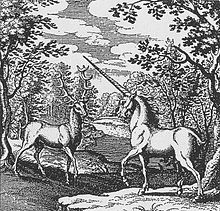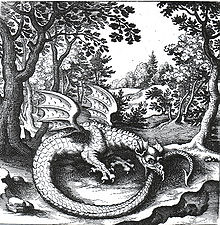Lambspring
Lambspring , Lamspring or Lambspringk is the unknown author of an alchemical German poem of the 16th century with 15 allegorical emblems.
The author worked in northern Germany around 1500. The text was first printed in 1599 by Nicolas Barnaud in his Triga Chemica collection (Leiden 1599) (without pictures) as De lapide philosophico , reprinted in the Theatrum Chemicum , in the Dyas chemica tripartita (1625, attributed to Johannes Grasshoff as editor), and in 1625 in the Musaeum Hermeticum , published by Lucas Jennis , reissued in 1678. In the 1625 edition by Jennis, the associated pictures are also included for the first time ( Matthäus Merian the Elder ). Handwritten versions of the work are in Nuremberg, Zurich and Leiden, with associated emblematic images.
In the 1625 edition, it is noted that the Latin text is from a translation by Nicolas Barnaud from the German. The title emblem shows a bearded man with a scepter and cloak with a double-headed eagle on his chest next to a multi-story, three-part oven. There is also a heraldic coat of arms of the alleged author (who introduces himself from a noble family) with a lamb lifting one leg.
The book avoids complicated allegorical symbols of other alchemical treatises and the pictures are rather simple and symbolize opposites, struggles and their overcoming:
- Emblem 1 shows a sailing ship on one foot and two fish swimming in opposite directions to the left and right banks and a city in the background.
- Emblem 2 shows a knight similar to St. George fighting a dragon in a forest with a river in the background.
- Emblem 3: Deer and unicorn facing each other, whereby unicorn often stands for the moon and the deer for the sun
- Emblem 4 shows a lion raising her right paw and a lioness raising her left paw, side by side in a forest (contrast between man and woman)
- Emblem 5 shows a wild wolf (facing east) and a dog (facing west) fighting, in the background a river with a bridge between the castle (side of the wolf) and church (side of the dog)
- Emblem 6 shows a dragon biting its tail (the ancient Ourobouros symbol)
- Emblem 7 shows two birds in a tree, one flies up, one crouches on the nest, the corresponding verse reflects the old hermetic motto of the Tabula Smaragdina , what is below holds the upper one.
- Emblem 8: A white and a red bird fight in a forest, one below, one above. The corresponding verse speaks of the conversion into white doves and the union into a phoenix.
- Emblem 9: A king sits on his throne (to which 7 steps lead and which has a roof on 4 pillars) with his feet on the defeated dragon. No forest can be seen, but a river and a city with a bridge in the background
- Emblem 10: A shirtless adept stokes a fire with a salamander.
- Emblem 11: An old king (left), a young prince (center, head tilted towards the father) and a bearded, winged spiritual leader (right) shake hands. In the background a river, on the left a city and on the right mountains. The prince symbolizes the adept (alchemist) on his way to perfection.
- Emblem 12: The prince is standing with his guide on the mountain, the sun (left), stars and moon (right) can be seen above, a landscape with a river in the background.
- Emblem 13: Return of the prince to the king (father) on his throne inside a castle and embrace, the leader is on the left in the background
- Emblem 14: the father / king lying in bed. Descending fog and secreted sweat from lying down indicate a process of transformation.
- Emblem 15: The prince sits on the left, the father on the right, in the middle the leader. The accompanying verse says that the Son always remains in the Father and the Father in the Son (with echoes of the Christian Trinity).
The emblems deal with the art of alchemy with the aim of producing the philosopher's stone, with which metals can be transformed and a universal medicine (Panacea) can be obtained. The allegorical symbols are based on older literature such as Alphidius . In the emblems 1–8 there are images like fish, unicorn, lion, dog for spirit , the second fish, deer, lioness and wolf for anima , bird Hermetis and eagle for Mercurius philosophorum (philosophical mercury), salamander and phoenix for the stone Wise men . The emblems from No. 9 onwards show alchemical transformations of anima, spiritus, corpus. The story father-son-guide at the end has direct parallels with Alphidius (short report and parabolic Tractätlein). In general, the alchemist, who transforms in parallel to his work, has been a well-known subject in alchemy since Zosimos of Panopolis .
The book had a significant impact in the 17th century and was translated into English and French. It also exerted an influence on esotericists from the end of the 19th century, as many reprints in the 20th century show. It appeared in English translation in the 1893 edition of the Hermetic Museum by Arthur Edward Waite .
Karl Christoph Schmieder traces the name back to Lamspringe , where there was a Benedictine abbey, others see an allusion to a leaping lamb as a symbol of renewal (similar to the Agnus Dei symbol). Sometimes the author is also listed by the first name Abraham.
literature
- Herwig Buntz: German alchemical treatises of the 15th and 16th centuries, Phil. Dissertation, Munich 1968
- Joachim Telle , Lamspring, in Walter Killy, Literaturlexikon, de Gruyter 2010
- Joachim Telle: Lamspring (Lambspring, Lambspringk, Lambsprinck, Lampert Spring), German alchemist , Lexicon of the Middle Ages , Volume 5, 1991, Sp. 1634-1635
- Joachim Telle: Lamspring, author's lexicon , Volume 11, 2004, S. Sp. 905
- John Ferguson: Bibliotheca Chemica, Glasgow 1906, Volume 2, p. 6
Web links
- Adam McLean, A Threefold Alchemical Journey Through the Book of Lambspring, Alchemy Website
- English translation of the Museum Hermeticum by Waite with the Lambspring
- Handwritten version from 1556 of Lambspring's alchemical didactic poem in the Zurich Central Library, doi : 10.7891 / e-manuscripta-6275
Individual evidence
- ^ Telle, Killy Literature Lexicon.
- ^ Telle: Lamspring, in Killy, Literaturlexikon.
- ↑ History of Alchemy, Halle 1832, p. 229.
| personal data | |
|---|---|
| SURNAME | Lambspring |
| ALTERNATIVE NAMES | Lambspringk, Lamspring |
| BRIEF DESCRIPTION | Alchemist |
| DATE OF BIRTH | 15th century |
| DATE OF DEATH | 16th Century |


